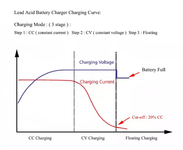player80
Full Member level 2
Hi,
can anyone give me a hint how to charge a lead acid battery?
The printing on the Battery says:
NP 4.5-12 (12V/4.5Ah/20HR)
Cycle use 14.4-15.5
Standby Use: 13.5-13.8
Initial Current: less than 1.35A
I saw following article.
this says:
First phase is constant current, typically 15% of AH rating.
I picked around 200mA until it reached 12.5V (measured with the multimeter)
Now I have set it to 600mA
The voltage increases slowly but is still below 13V and it draws 0.6C so at that stage I have to wait until the current drawn decreases?
Cycle use 14.4-15.5 does that mean I can charge with 15.5V until it reaches around that?
Standby Use can anyone elaborate what exactly that means?
I have seen quite a few videos about it and read some articles but it all ends up to be a bit confusing about it. Of course I couldn't find any datasheet either...
can anyone give me a hint how to charge a lead acid battery?
The printing on the Battery says:
NP 4.5-12 (12V/4.5Ah/20HR)
Cycle use 14.4-15.5
Standby Use: 13.5-13.8
Initial Current: less than 1.35A
I saw following article.
this says:
First phase is constant current, typically 15% of AH rating.
I picked around 200mA until it reached 12.5V (measured with the multimeter)
Now I have set it to 600mA
The voltage increases slowly but is still below 13V and it draws 0.6C so at that stage I have to wait until the current drawn decreases?
Cycle use 14.4-15.5 does that mean I can charge with 15.5V until it reaches around that?
Standby Use can anyone elaborate what exactly that means?
I have seen quite a few videos about it and read some articles but it all ends up to be a bit confusing about it. Of course I couldn't find any datasheet either...

